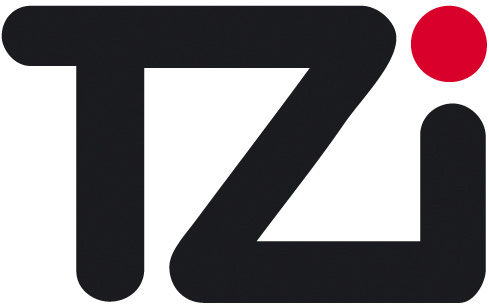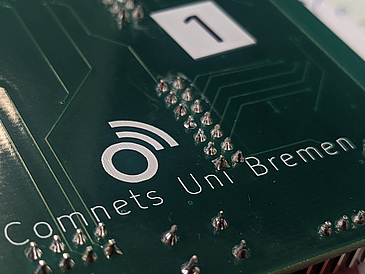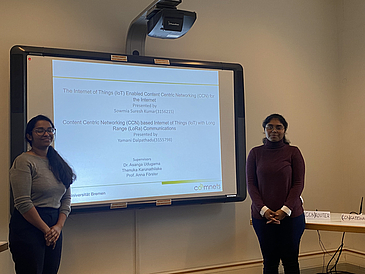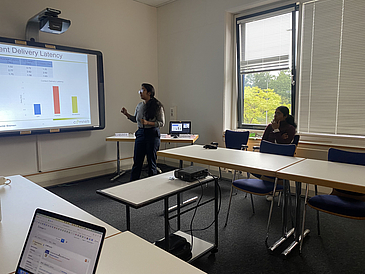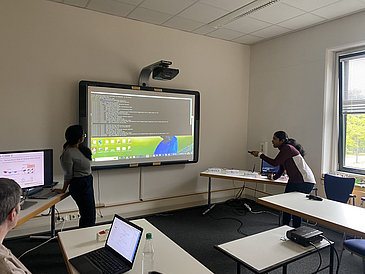Sowmia Suresh Kumar and Yamani Dalpathadu successfully defended their combined work on implementing and evaluating Content-Centric Networking (CCN) for the Internet of Things (IoT). Sowmia focussed on implementing CCN for the Internet, while Yamani focussed on the Sensor Network side. The implementations were specifically for resource-restricted devices, using Python and Micro-Python as the development language. In addition to presenting the implementation details and the performance evaluation, they also demonstrated the complete system in operation using WiFi and Ethernet for communications in the Internet and LoRa on the sensor network side. The titles and the abstracts are given below.
We congratulate them on their success and wish them good luck for their futures.
The Internet of Things (IoT) Enabled Content-Centric Networking (CCN) for the Internet
Student: Sowmia Suresh Kumar
A pull-type communication technique is used in content-centric networking, where information flow only happens in response to requests. The IoT is perfectly suited to employ CCN for communications since it is largely an information-carrying network. IoT devices, such as sensors, can communicate with the Internet to exchange data for various purposes. Due to resource limits, pull-type communications are regarded as inappropriate for IoT devices. This thesis study suggests push-type techniques for publish-subscribe-based applications to avoid pointless data transmissions. The goal here is to create a hardware setup that supports CCN-based Internet and assess the effectiveness of the system that has been put in place to support various IoT use cases. To assess the deployed system, the IoT network's operations, including the gateway that manages both the Internet and the IoT sides, are simulated. The entire system is made up of Python3-programmed hardware elements like Raspberry Pi. The effectiveness of the developed CCN-enabled Internet infrastructure was tested through several experiments using an application for a smart university environment monitoring system. With a content delivery ratio of 1.0, the findings demonstrated excellent network content retrieval efficiency. Content retrieval improved via in-network caching in intermediate CCN routers, and no packet losses were noticed. The Reflexive Forwarding extension maximized content delivery for periodic content retrieval scenarios. Better caching policies are needed since network caches send some users outdated content. To stop subscribers from accessing cached data from routers, the gateway issued a particular Record ID. Recommendations on improvements and features that may be added to the system to make it more useful, such as mobility and intelligent automobile systems, could be considered for future work. Security features like content encryption could be required to avoid cache poisoning, which was not covered in this thesis work.
Content-Centric Networking (CCN) based Internet of Things (IoT) with Long Range (LoRa) Communications
Student: Yamani Dalpathadu
The Internet of Things (IoT) is a transformative concept that expands the capabilities of the Internet by incorporating a diverse range of devices into its ecosystem. The presence of various sensors and actuators characterizes the IoT. Information-Centric Networking (ICN) is an emerging networking paradigm that aims to shift the paradigm of Information-Centric Networking. The main paradigm in ICN is that it considers content caching. In-network caching enables the ICN to gain huge performance advantages by caching content. Due to the resource limitations inevitable in IoT networks, push-type communication has to be focused on. Reflexive Forwarding for CCN is an extension of CCN that can handle complex data flow scenarios, and this protocol can be used to effectively exchange data between CCN-enabled IoT and CCN-enabled Internet networks. The proposed setup was implemented on a hardware test bed. The performance evaluation of the proposed setup has been conducted using different use-case scenarios that can be categorized as either a publish/subscribe or query/response type of event. The results showed that the utilization of in-networking caching proved efficient, but it was observed that it facilitated the expedited retrieval of content. The use of Record-ID always made sure that subscribers always received fresh data. Overall, using Reflexive Forwarding for CCN was shown to be very beneficial for data communications in the system.

